- Home
- Clive Cussler
Plague Ship tof-5 Page 5
Plague Ship tof-5 Read online
Page 5
Mr. Murphy thinks he should hire a private investigator.” Cabrillo scoffed. “I think he should drop this whole Internet thing and meet women the regular way, face-to-face, in a bar over too many drinks.”
“Hear! Hear! One can’t overstate the social lubricating abilities of a few cocktails.” Maurice tidied Cabrillo’s desk and hoisted the serving dish to his shoulder, a fresh linen napkin over his other arm.
“We’ll see you when you return.”
That was as close as the steward would say to “Good luck.”
“Not if I don’t see you first,” was Juan’s customary reply.
They left the cabin together, Maurice turning right to return to the galley, Juan left. He took an elevator down three decks. The doors opened to a cavernous room lit with ranks of floodlights and smelling strongly of the sea. An overhead crane held the larger of the two submersibles the Oregon carried, a sixty-five-foot Nomad 1000. The blunt-nosed mini-sub could carry six people, including a pilot and copilot. Clustered near her three bow portholes were armored xenon lamps and an articulated manipulator arm with a grip that could rip steel. The Nomad was rated for a thousand-foot depth, almost ten times as much as her little sister, the Discovery 1000, hanging suspended in a cradle above it, and was outfitted with a diving chamber, so swimmers could exit the craft while she was submerged.
Beneath the submersible, crewmen had already pulled the deck grating away to reveal a gaping pit that went all the way to the Oregon’s keel. The outer doors were still closed, but pumps were filling the swimming pool-sized opening in preparation for the launch.
Linc, Eddie, and Max were already sliding black wet suits over their swim trunks. Scuba equipment for all of them had already been loaded into the sub. Linda Ross stood with her arms crossed over her chest, watching Max with amusement. Hanley had served two tours in Vietnam as a Swift Boat captain and no longer cut the dashing figure he once had. He was having a hard time stretching the suit over his paunch.
He didn’t normally accompany a team on a shore excursion; however, he was the best marine engineer in the Corporation, and everyone agreed his expertise could come in handy.
“Come on, old boy,” Juan said with a grin, and patted Max’s belly. “I don’t recall you having this much trouble a few years ago.”
“It’s not the years,” he moaned, “it’s the pastries.” Cabrillo sat on a bench and, unlike the others, started to put a dry suit on over his clothes. “Linda, have you done your prelaunch checks?”
“We’re good to go.”
“And the cradle?”
“It’s secure,” Max answered for her with possessive pride. He’d designed it, and had overseen its fabrication in the Oregon’s machine shop.
Juan took a communications headset from an attending engineer and called up the Op Center. “Hali, it’s the Chairman. How’s it look out there?”
“Radar shows the normal procession of tankers heading in and out of the Gulf. There’s a containership that pulled into Bandar Abbas’s main dock about two hours ago, plus a handful of feluccas and dhows.”
“Nothing from the naval base?”
“They’re quiet. I’ve scanned all frequencies, and, other than normal blather between ships at sea, there’s not much going on.”
“I hope you’re honing your language skills.” It was a joke between the two. Hali Kasim was the son of Lebanese parents but couldn’t speak a word of Lebanese or Arabic, one of four languages in which Cabrillo was fluent.
“Sorry, boss, I’m letting the translating algorithms of the computer do the work for me.”
“Eric, Murph, you guys set to go?”
When Cabrillo was sending a team ashore, there were no better officers to have manning the ship’s navigation and weapons systems than Stone and Murphy.
“Yes, sir,” the two said in unison. Murph added, “We are locked and loaded and ready to be goaded.” Juan groaned. Murph’s newest hobby was slam poetry, and, despite the crew’s repeated assertions to the contrary, he thought he was a master of the edgy street genre. “Stand by for a comm check once we’re secured in the Nomad.”
“Roger that,” Hali replied.
Linc and Eddie gathered up the waterproof bags containing their weapons and gear and climbed atop the mini-sub. They vanished into the hull through the small hatch. Max and Cabrillo followed them up, Juan giving the thick steel hull a superstitious slap before descending into the submersible. The ride to shore would take an hour, so they took their seats along the mini’s flanks rather than cram half the team into the two-man dive chamber. All four of them would don their scuba equipment during the trip in.
Linda Ross wiggled her way past Juan and Max and took her place in the pilot’s seat, a low-slung chair surrounded by banks of switches, dials, and computer monitors, their glow giving her face an eerie green cast.
“How do you read me, Oregon?” she asked after settling her own headset over her tousled hair.
“Five by five.” Their communications system used 132-bit encryption and cycled through frequencies every tenth of a second, so the chance of intercept and decryption was zero.
The men in the back of the submersible also checked in. The dive helmets they were to wear had integrated ultrasonic transceivers to allow easy communications among themselves, the Nomad, and the Oregon.
“Okay, you can open her up,” Linda ordered.
The lights in the moon pool were dimmed, so as not to show underwater, as the keel doors slowly hinged open. The mechanism that lowered the submersible was engaged. The mini-sub lurched suddenly and then began its stately descent. The warm Gulf water soon lapped against the portholes, before the vessel sank to its neutral buoyancy point. The clamps were disengaged, and the Nomad bobbed free.
Linda activated the ballast pumps, slowly drawing water into the tanks, and gently eased the sub out through the bottom of the Oregon ’s hull. Though she had done it dozens of times, her motions were careful and deliberate. She watched the depth gauge and the laser range finder mounted on the top of the submersible, to ensure they had cleared the keel.
“Nomad is free,” she said, when they were twenty feet below the hull.
“Closing the doors. Oregon over and out.”
Linda descended another forty feet, until the seafloor was just a yard or two below the mini, and set her course for the Bandar Abbas naval base. She kept her speed to just above a crawl so the sound of the propellers churning the water wouldn’t alert any attentive sonar operators in the area, although with the amount of traffic in the Strait of Hormuz it would be next to impossible to single out the whisper-quiet Nomad amid the acoustical clutter.
They were at risk of visual detection because the waters were so shallow, forcing her to leave off the external lights. She would have to rely on the LIDAR system, or Light Detection and Ranging system, which used a series of reflected lasers to map out the terrain immediately in front of the sub. She would get them to the base by following the three-dimensional computer representation of their surroundings.
The LIDAR could detect objects as small as a soda can.
“This is your pilot, up here in the cockpit,” she called over her shoulder. “We will be cruising at an altitude of negative forty-eight feet at a speed of three knots. Our estimated arrival time at our destination is approximately sixty-two minutes. At this time, you may use approved electronics, and don’t forget to ask an attendant about our frequent-flier program.”
“Hey, Pilot, my peanuts are stale,” Linc called up to her.
“Yeah, and I want a blanket and a pillow,” Eddie added.
Max chimed in, “While you’re at it, a double Scotch would hit the spot.” Listening to the banter over the next half hour, one would have never known they were about to infiltrate Iran’s most heavily secured naval facility. It wasn’t that they weren’t aware of the risks. It was just that they were too professional to let that wear on their nerves.
But all that dried up with thirty minutes to go. The shor
e team started putting on their scuba gear, checking and rechecking each other’s equipment as they went. When they were suited up, Juan and Linc slid their way into the phone booth-sized air lock. There was a hatch in the ceiling of the claustrophobic chamber that could be opened from the cockpit or from inside the air lock, but only when the pressure on each side of the armored door was equalized. To save time, Juan hit the controls that allowed seawater to slowly fill the chamber. The water was blood warm as it climbed up their bodies, pressing in on Juan’s dry suit. Juan had to smooth out the wrinkles so the suit wouldn’t chafe. Both men had to work their jaws to ease the pressure on their inner ears.
When the level was just below their necks, Cabrillo hit the button again. There was no need to put on their dive helmets until the last moment.
“How are you doing back there?” Linda’s voice was tinny and distant through the helmet.
“Why is it I always get stuck in this thing with the biggest member of the crew,” Juan cried theatrically.
“’Cause Max’s belly’s too big to fit in there with Linc, and Eddie would be squashed like a bug,” Ross said.
“Hey, man, just be thankful I don’t take a deep breath,” Linc joked in his deep baritone.
“Chairman, the LIDAR is picking up the submarine pen’s doors. We’re about fifty yards away.”
“Okay, Linda. Put us on the bottom to the right of the dry dock’s entrance.”
“Roger.”
A moment later, the Nomad shuddered slightly as Linda settled it onto the sandy seafloor. “Powering down all nonessential equipment. Whenever you’re ready.”
“What do you say, big man?” Cabrillo asked Lincoln.
“Let’s do it.”
Juan put on his helmet, making sure the locking rings to keep the suit watertight were secure and that he was getting sufficient air from the tanks. Cabrillo waited until Linc gave him the dive signal for “OK” before opening the flood valve again. The water quickly rose to the air lock’s ceiling. He doused the lights and hit another toggle to open the door.
The hatch swung upward, releasing a small amount of trapped air. The bubbles were silver-white in the gloom, but with waves lapping against the enclosed pier they wouldn’t be spotted.
Juan hoisted himself out of the dive chamber and paused on the submersible’s upper deck. Without lights, the water was as dark as ink. Cabrillo had grown up in southern California and had been drawn to the sea for as long as he could remember. He graduated from skin diving to scuba diving and from body boarding to surfing in his early teens. He was as comfortable in water as a seal and was almost as powerful a swimmer. The darkness only enhanced the calm he felt whenever he dove.
Lincoln emerged from the Nomad a moment later. Juan closed the hatch, and together they waited for Eddie and Max to cycle through. Once they were all out of the submarine, Cabrillo chanced turning on an underwater flashlight, shielding the beam from the surface with his hand.
The Iranian submarine pen had been built by first excavating a six-hundred-foot-long, hundred-foot-wide trench from the ocean eastward into the desert. Over this, they erected a reinforced-concrete shell, supposedly eight feet thick and capable of withstanding a direct bomb hit. It had been built before the U.S.-led invasion of neighboring Iraq, and the Iranians must be well aware that some of the bunker busters in the American arsenal now could level the entire structure with a single hit. To the south and north of the dry dock sat the main piers of the naval base, while administration buildings, machine shops, and barracks sprawled for two miles inland.
On the seaward side of the pen were two massive doors that swung outward hydraulically. Inflatable bladders sealed the gap between the bottom of the door and a cement pad to keep water from flooding into the building. Short of explosives or a couple of hours with an acetylene cutting torch, the doors were impenetrable.
Cabrillo finned away from the doors, leading his team through the stygian realm. Every few moments, he would flash his light along the barnacle-encrusted seawall protecting the base from the ravages of the ocean. After fifty feet, the beam settled on what he had been searching for. There was a four-foot-wide culvert in the wall, a dark hole that fed the pumps to drain the dry dock. Careful to protect the light, he inspected the metal grille embedded in the concrete that prevented anything from swimming up the conduit. The steel was only slightly corroded, while the concrete maintained its integrity. It took him over a minute of careful inspection to spot the wires at the top and bottom of the six metal rods.
One way to protect against tampering was to rig the grates with motion detectors, but with so many curious fish in the Persian Gulf the alarms would sound almost constantly. The easier way was to run an electric current through the metal, and if the connection was ever cut guards would be alerted that someone had removed part of the grille.
Juan pointed the wires out to Linc, the Corporation’s best infiltration specialist. Working mostly by feel, Lincoln rigged bypasses on three of the steel rods, using alligator clamps and lengths of wire to keep the current flowing. Next, he removed two squeeze tubes from his dive bag. He uncapped one tube and applied a bead of a gray puttylike substance around the ends of the bars. He then applied an equal amount of putty from the second tube over the first.
Inert when separated, the two compounds formed a caustic acid when combined. In less than a minute, the metal under the beads had been eaten away enough for Linc to snap them free, his loose wires still keeping the circuit closed and the alarms silent. He set the broken rods on the sand, making sure he didn’t touch the still-corrosive tips, and held the slack wires apart for Max, Eddie, and Juan to slip through before carefully sliding into the pipe himself.
Now that they were sheltered from prying eyes, Juan turned up the intensity of his dive light, its beam forming a white ring circling the curved sides of the conduit that seemed to retreat with the pace of his advance.
A fast shadow suddenly lunged at him. He struck out blindly as a darting shape passed him by. He caught sight of a dorsal fin and the rapier tail of a baby shark before it vanished behind him.
“Good thing we met him now and not in a couple of years,” Eddie quipped.
Cabrillo needed a second for his heart to slow before continuing down the constricting pipe. He was jumpier than he’d thought, and that didn’t bode well.
The conduit fed into a large valve that would be in the closed position if the dry dock was empty, but, in the two days the crew had been watching the facility, they had seen no indication the Iranians had pumped out the sub pen since their navy’s newest Kilo Class diesel-electric boat had been admitted.
The four men squeezed through the butterfly valve and into the monstrous pump that could drain the pen.
The impeller blades were made of bright ferrobronze that had been bolted to the hub.
Juan had come prepared for bolts, and, in case the blades had been welded, he carried a small torch. He pulled an adjustable wrench from a pouch on his thigh and attacked the bolts. The angles were awkward, and the nuts had been screwed in place by a pneumatic gun, so it took all his effort to get each of the twelve bolts started. One in particular had him straining so hard that pinwheels of colors exploded behind his tightly closed eyes. When the seal finally popped, the wrench kicked free, and Cabrillo sliced his hand on the scimitar-shaped blade. A small cloud of blood hung in the glow of his flashlight.
“Trying to get the shark to come back?” Max teased.
“So long as your big butt is between me and him, I’ll be fine.”
“It’s not big, just well padded.”
Juan finished with the bolts and set each of the eighteen-inch impeller blades aside. He had to unsling his scuba tank and wriggle beneath the pump’s hub to make it through. He waited on the other side for the men to join him and slide their tanks back in place.
The pipe continued for another dozen feet before turning ninety degrees. Cabrillo shut off his light, and, after waiting a moment for his eyes to adjus
t, could make out a pale, watery corona coming from around the bend. He cautiously swam closer, and when he reached the turn he ducked his head around for a quick peek.
They had reached the dry dock. The light was coming from fixtures mounted on the tall ceiling. The low level told him that there was just enough illumination for guards to patrol the pen but not enough for a slew of technicians to be working on the Kilo. As they had anticipated, there wouldn’t be more than a handful of men to subdue.
Cabrillo swam out of the pipe and dove down to stay along the concrete bottom, followed by Max, Linc, and Eddie. They made their way closer to the towering doors, where there was the least chance of there being guards. Juan checked their depth on his dive computer and held the men at ten feet for a minute, to allow the small amount of nitrogen bubbles that had accumulated in their bloodstream to dissolve.
With the patience of crocodiles emerging from a river in pursuit of prey, the four men approached the surface, hovering just below its silvery reflection in order to affix small periscopes to their helmets.
Capable of magnifying starlight so that it shone as light as day, the third-generation optics of the scopes had to be dialed back a bit as they slowly searched every corner of the dry dock from the security of the water.
The dry dock was wide enough for two ships to be serviced side by side, and each edge of the sub pen was flanked with raised cement jetties that ran almost the entire length of the building. They were littered with equipment, barrels of lubricant, piles of gear under tarps, small electric golf carts to make moving around easier, and a trio of forklifts. At the far end was a raised platform that stretched the width of the building. Part of it was glassed in to make an office or observation room, and under it, on each side, were enclosed spaces for secure storage. There was also an overhead crane on rails that could reach any part of the covered dock.
Tied to one side of the pier by thick Manila lines was the ominous black shape of a Kilo Class attack submarine. The twenty-two-hundred-ton vessel had once been the most feared sub in the Soviet arsenal.

 Deep Six
Deep Six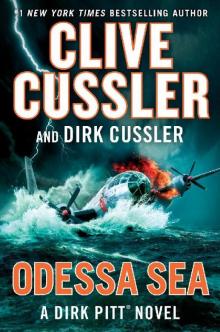 Odessa Sea
Odessa Sea Flood Tide
Flood Tide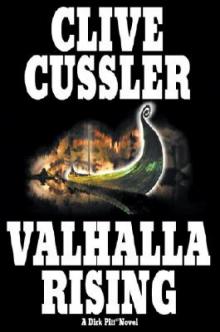 Valhalla Rising
Valhalla Rising Thriller 2
Thriller 2 The Tombs
The Tombs Lost Empire
Lost Empire The Gray Ghost
The Gray Ghost The Eye of Heaven
The Eye of Heaven Polar Shift
Polar Shift The Kingdom
The Kingdom Trojan Odyssey
Trojan Odyssey Shadow Tyrants
Shadow Tyrants Nighthawk
Nighthawk Blue Gold
Blue Gold Serpent
Serpent Lost City
Lost City The Gangster
The Gangster White Death
White Death Inca Gold
Inca Gold The Mayan Secrets
The Mayan Secrets The Pharaoh's Secret
The Pharaoh's Secret The Emperor's Revenge
The Emperor's Revenge Corsair
Corsair Sacred Stone
Sacred Stone The Silent Sea
The Silent Sea The Rising Sea
The Rising Sea Black Wind
Black Wind Fast Ice
Fast Ice Ghost Ship
Ghost Ship Marauder
Marauder The Thief
The Thief Medusa
Medusa Typhoon Fury
Typhoon Fury Journey of the Pharaohs
Journey of the Pharaohs The Navigator
The Navigator The Saboteurs
The Saboteurs Crescent Dawn
Crescent Dawn Skeleton Coast
Skeleton Coast Wrath of Poseidon
Wrath of Poseidon The Mediterranean Caper
The Mediterranean Caper The Romanov Ransom
The Romanov Ransom Treasure
Treasure The Race
The Race The Bootlegger
The Bootlegger Spartan Gold
Spartan Gold Havana Storm
Havana Storm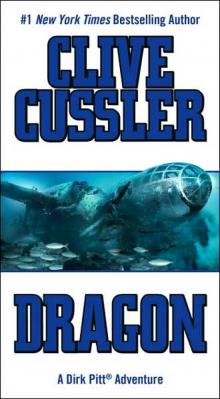 Dragon
Dragon Piranha
Piranha Poseidon's Arrow
Poseidon's Arrow The Cutthroat
The Cutthroat Atlantis Found
Atlantis Found The Jungle
The Jungle The Oracle
The Oracle Treasure / Dragon / Sahara: Clive Cussler Gift Set
Treasure / Dragon / Sahara: Clive Cussler Gift Set Clive Cussler and Dirk Pitt Revealed
Clive Cussler and Dirk Pitt Revealed The Sea Hunters
The Sea Hunters Pirate
Pirate The Striker
The Striker Plague Ship
Plague Ship The Wrecker
The Wrecker Iceberg
Iceberg The Chase
The Chase The Spy
The Spy Golden Buddha
Golden Buddha The Titanic Secret
The Titanic Secret Zero Hour
Zero Hour Fire Ice
Fire Ice Dark Watch
Dark Watch The Storm
The Storm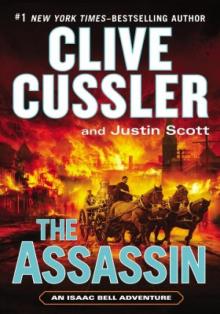 The Assassin
The Assassin Vixen 03
Vixen 03 Arctic Drift
Arctic Drift Night Probe!
Night Probe! Cyclops
Cyclops Medusa nf-8
Medusa nf-8 Shock Wave dp-13
Shock Wave dp-13 Marauder (The Oregon Files)
Marauder (The Oregon Files) Lost Empire fa-2
Lost Empire fa-2 Arctic Drift dp-20
Arctic Drift dp-20 Dirk Pitt 22 - Poseidon's Arrow
Dirk Pitt 22 - Poseidon's Arrow Treasure of Khan dp-19
Treasure of Khan dp-19 Dark Watch of-3
Dark Watch of-3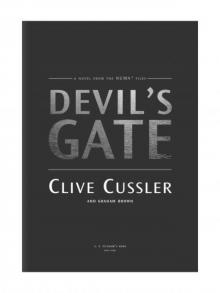 Devil's Gate
Devil's Gate The Sea Hunters II: More True Adventures with Famous Shipwrecks
The Sea Hunters II: More True Adventures with Famous Shipwrecks Flood Tide dp-14
Flood Tide dp-14 The Mediterranean Caper dp-2
The Mediterranean Caper dp-2 Iceberg dp-3
Iceberg dp-3 Sahara dpa-11
Sahara dpa-11 Pacific Vortex! dp-1
Pacific Vortex! dp-1 Deep Six dp-7
Deep Six dp-7 Dragon dp-10
Dragon dp-10 Serpent nf-1
Serpent nf-1 Havana Storm (Dirk Pitt Adventure)
Havana Storm (Dirk Pitt Adventure)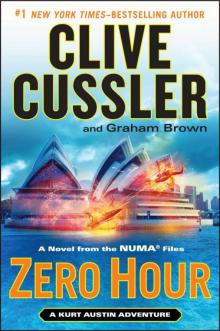 Zero Hour nf-11
Zero Hour nf-11 The Storm nf-10
The Storm nf-10 The Thief ib-5
The Thief ib-5 Lost City nf-5
Lost City nf-5 The Mayan Secrets fa-5
The Mayan Secrets fa-5 White Death nf-4
White Death nf-4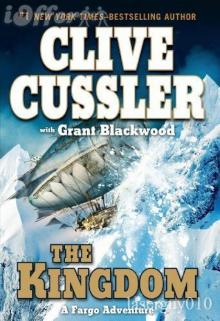 The Kingdom fa-3
The Kingdom fa-3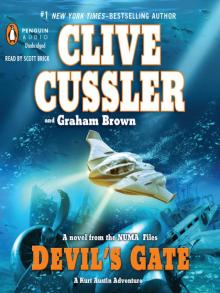 Devil's Gate nf-9
Devil's Gate nf-9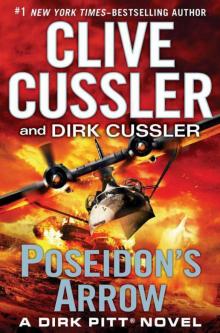 Poseidon's Arrow dp-22
Poseidon's Arrow dp-22 Raise the Titanic dp-4
Raise the Titanic dp-4 Shadow Tyrants--Clive Cussler
Shadow Tyrants--Clive Cussler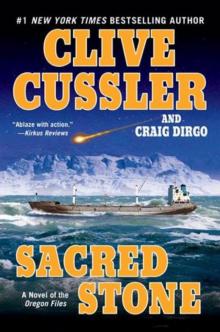 Sacred Stone of-2
Sacred Stone of-2 Skeleton Coast tof-4
Skeleton Coast tof-4 Mirage tof-9
Mirage tof-9 The Jungle of-8
The Jungle of-8 The Emperor's Revenge (The Oregon Files)
The Emperor's Revenge (The Oregon Files) Golden Buddha of-1
Golden Buddha of-1 Blue & Gold
Blue & Gold The Tombs fa-4
The Tombs fa-4 Inca Gold dp-12
Inca Gold dp-12 Treasure dp-9
Treasure dp-9 Atlantis Found dp-15
Atlantis Found dp-15 Black Wind dp-18
Black Wind dp-18 the Silent Sea (2010) tof-7
the Silent Sea (2010) tof-7 The Wrecker ib-2
The Wrecker ib-2 Fire Ice nf-3
Fire Ice nf-3 The Chase ib-1
The Chase ib-1 Sahara
Sahara The Striker ib-6
The Striker ib-6 Polar Shift nf-6
Polar Shift nf-6 The Race ib-4
The Race ib-4 Corsair of-6
Corsair of-6 Cyclops dp-8
Cyclops dp-8 The Navigator nf-7
The Navigator nf-7 Plague Ship tof-5
Plague Ship tof-5 Sea of Greed
Sea of Greed Vixen 03 dp-5
Vixen 03 dp-5 Thriller 2: Stories You Just Can't Put Down
Thriller 2: Stories You Just Can't Put Down